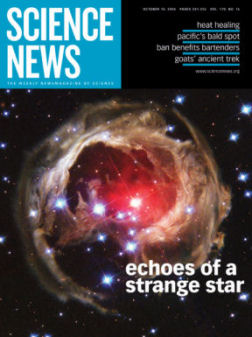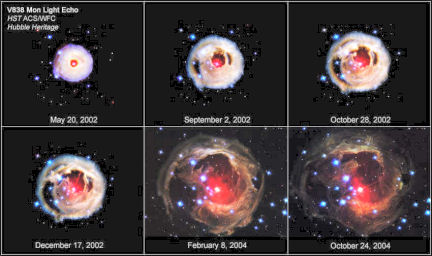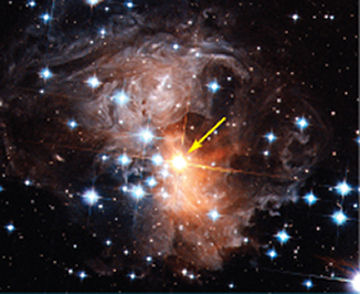An erupting star near the outskirts of the Milky Way has become one of the most puzzling objects in the galaxy. The star’s outburst has set aglow a never-before-seen array of dust eddies, shells, and spirals—a cosmic portrait reminiscent of the whirling patterns of Van Gogh’s “Starry Night.” But even as astronomers marvel at the artistic display generated by the distant star, dubbed V838 Monocerotis, they’re stumped by its behavior.



“We’ve never seen anything like this,” says Howard Bond of the Space Telescope Science Institute in Baltimore.
Although the erupting star briefly became one of the brightest stars in the galaxy, it has now dimmed and become one of the coolest. Moreover, instead of hurling into space its outer layers of material, as happens in a common type of stellar explosion, the star swelled to a gargantuan diameter as large as the average distance between the sun and Saturn.
Theorists have come up with several explanations for the star’s extraordinary behavior: a thermonuclear explosion on the star’s surface, a collision with an unseen companion, the swallowing of one or more closely orbiting planets. But none of these models fits exactly the fireworks observed. As astronomers work to solve the puzzle of V838 Monocerotis, they’re applying their breadth of knowledge about the evolution of stars, and they’re confronting what they still don’t understand about stars and how they erupt.
Puzzling portrait
Few astronomers paid much attention in January 2002 when amateur astronomer Nicholas J. Brown of Quinns Rocks, Australia discovered V838 Monocerotis as a brightening star. Within days, the star faded, fitting the pattern of a common type of outburst—called nova from the Latin word for “new star”—that astronomers had documented many times before.
Novas occur when a white dwarf—the dense cinder of a sunlike star—steals matter from a puffier companion star. When the material piling onto the surface of the white dwarf reaches a critical density, it sparks a thermonuclear explosion. The outburst is observed as a jump in brightness over a wide range of wavelengths. Novas can recur as often as every few years as the dwarf accumulates additional material from its partner.
Astronomer Sumner Starrfield of Arizona State University in Tempe says the nova detected by Brown seemed typical. “I don’t think anyone was doing anything extraordinary to follow it” because it seemed so run-of-the-mill, Starrfield says.
But just a month after its discovery, the blue-tinged star had a sudden resurgence. It grew about 30 times brighter in a single day, outshining nearly every other star in the Milky Way. After fading in mid-February 2002, it bloomed a third and final time in March of that year, ballooning to 500 times its original width before slowly fading. It also dropped in temperature from 6,000 kelvins, slightly hotter than the sun’s visible surface, to 2,000 K and took on a reddish hue.
That’s in striking contrast to a classic nova in which a star’s outer layers, cast off during an explosion, gradually expand and thin to reveal the blue, still-hot white dwarf that remains behind. The dwarf emits X rays and ultraviolet radiation, neither of which was detected from V838 Monocerotis.
This erupting star “does not resemble any nova that has been studied,” says Starrfield. By monitoring the intensity of individual wavelengths of the infrared light from the outburst, astronomers have determined that V838 Monocerotis is a binary star system. It consists of a blue supergiant star and a cool star. The supergiant is just a bystander, the cool star is the one that ballooned so dramatically.
V838 Monocerotis is “the prototype of a new class of star,” assert Israeli astrophysicist Alon Retter and his colleagues in a recent review article. Retter, Bond, and several other astronomers described their theories and observations of V838 Monocerotis at a conference in La Palma, Spain, in May and have recently posted the reviews online (see “References,” below).
Myriad models
Astronomers have come up with several theories to explain the bizarre properties of V838 Monocerotis. Retter and his colleagues have suggested that the ballooning star engulfed a trio of unseen planets in rapid succession. Each of the three peaks in the star’s outbursts might have corresponded to the consumption of a planet, Retter says. He and his team calculate that the energy unleashed by planet swallowing—the point when the planet’s gravitational energy is absorbed by the parent star—would account for the observed brightening of the star.
Each planet would have to have been a so-called hot Jupiter, a body as massive as our solar system’s giant planet but that circles the star at only about a tenth of the distance between Mercury and the sun.
Astronomers have discovered more than two dozen such planets closely orbiting other stars over the past decade, although they don’t know whether any planet circles V838 Monocerotis.
In the mid-August Monthly Notices of the Royal Astronomical Society, Retter and his colleagues argue that the consumption of even a single hot Jupiter could account for the multistage outburst. In this scenario, a lone Jupiter-mass planet halts three times as it plummets into the inflating star, unleashing energy during each stop. The incoming orb finally comes to rest about a solar radius from the star’s core.
The planet-gorging model is also one way to account for the lithium that researchers have observed in the star. Lithium can barely be detected in most stars because it mixes readily into a star’s core, where nuclear reactions destroy it. A freshly digested planet rich in lithium would temporarily boost a star’s surface abundance of the element.
But stars as young as V838 Monocerotis haven’t had a chance to mix lithium into their cores and would have high concentrations of the element at their surfaces even without invoking planet swallowing, notes Mark Rushton of Keele University in England.
Rushton, Starrfield, and several other researchers contend that planet swallowing doesn’t provide enough energy to power the eruption of V838 Monocerotis. “I’m very skeptical [because] the energetics are all wrong,” says Starrfield. “I’ve been telling this to Alon [Retter] for 3 years, and we’ve never convinced each other.”
“In principle, a collision of a … star with a planet can lead to [an outburst], but not as bright as that of V838 Monocerotis,” assert Noam Soker of the Technion University in Haifa, Israel, and Romuald Tylenda of the Copernicus Astronomical Center in Torun, Poland, in a review article recently posted online (http://xxx.lanl.gov/abs/astro-ph/0606371).
According to Soker and Tylenda, a stellar crash is a more promising model. They propose that a low-mass star, one-tenth to one-third the mass of the sun, collided and merged with V838 Monocerotis, generating the fireworks. A third star might have been part of this fragile stellar partnership and might have been ejected during the merger. By getting kicked out of the system, this third star could have brought the two colliding stars together.
An analysis of such a collision suggests that the merger would rapidly produce a red, puffy star, as required for the V838 Monocerotis outburst, Soker and Tylenda argue. The researchers describe this latest work in the May Astronomy & Astrophysics.
“All models I know of to explain V838 Monocerotis, beside the stellar-merger model, were invented after the eruption and had to be twisted to fit some of the properties,” says Soker. Retter counters that the energy produced by a collision with a low-mass star isn’t much greater than that generated when a heavy planet is swallowed.
But Starrfield says that he worries that just as planet dining might produce too little energy, a stellar collision might produce too much. He suggests yet another theory—that the outburst might be the result of an unusual nova, in which a thermonuclear explosion is triggered on the surface of a cool star—a white dwarf—rather than a hot, blue star. The explosion would then merely be the most recent among a string of cosmic bombs that the star has detonated over the past few thousand years. But exactly how cool stars might spark these explosions remains unclear.
A dusty resolution?
About 2 months after V838 Monocerotis’ discovery, astronomers awoke to the artistic side of the odd star: It had begun to show light echoes. Similar to the sound of a hand clap reverberating from the walls of an empty ballroom, flashes of light from the star’s outburst scattered off clumps of surrounding dust, setting them aglow like a string of lightbulbs that switch on sequentially. The light echoes create the illusion of a halo of dust expanding faster than light, but the dust isn’t actually moving. The light simply brings different parts of the dust clouds into view at different times.
In April 2002, the Hubble Space Telescope got into the act. Astronauts had installed a new detector on Hubble, the Advanced Camera for Surveys, with twice as large a field of view as Hubble’s previous workhorse instrument had and about double its sensitivity.
Soon after the light echoes were discovered, a team including Bond and Starrfield asked for time with the new camera to capture several images of V838 Monocerotis. Some people consider those images among the most stunning that Hubble has ever recorded. The pictures, as well as ones recorded as recently as last month, may shed light on the true nature of the stellar outbursts.
It all depends on whether the illuminated dust came from previous outbursts of the star or was already there as part of the interstellar medium. By observing the light echoes, astronomers plan to develop a three-dimensional map of the dust and determine the origin of the material, notes Bond. That, in turn, may provide a clue about which of the outburst models is correct. The nova model, for instance, predicts that much of the dust was expelled by the star in a series of thermonuclear explosions.
The amount of dust in the echoing region provides another way to discriminate between the models. If the dust is more than 10 times as great as the mass of the sun, it couldn’t have come from a young star, says Soker. Preliminary estimates suggest that the region contains 100 to 1,000 solar masses of material, he says.
Measurements of the star’s spin, as well as determinations of whether V838 Monocerotis sports a dusty disk, could make or break the stellar-merger model. In that scenario, the collision induces high angular momentum in V838 Monocerotis. Like the proverbial ice skater who pulls in her arms to speed her spin, the star rotates faster as it contracts. Evidence for such fast rotation would support the merger scenario, notes Soker. The high spin rate created by the merger would also produce a dense, dusty disk rapidly rotating around the star. This disk might be revealed as the star shrinks.
Another way to distinguish among the models may be to determine whether the star has a close, surviving companion. The nova theory predicts that the star has a partner star from which it siphons material. In contrast, the merger model predicts that a close companion couldn’t have survived the 2002 eruption. It would have been destroyed during the collision.
Some of the developments that would indicate the origin of the fireworks from V838 Monocerotis are still several years in the future. In the meantime, astronomers have some beautiful pictures adorning their walls—and an intriguing stellar mystery.







